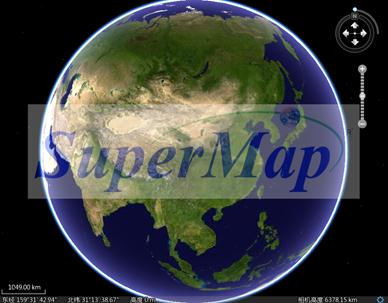In a 3D scene, the data is loaded onto the spherical ball and the 3D scene is the same as the 2D map. The data is displayed and managed in the form of a layer. The layers in the scene can be divided into three categories: normal layers, screen layers, and terrain layers.
- 1. Normal Layer
The ordinary layer is used to load data display. In a 3D scene, there can be multiple ordinary layers. Ordinary layers can beset in style to be saved in the 3D scene. When the 3D scene is opened next time, the layer will be automatically loaded into the scene by the saved style. The position of the object in the common layer is fixed relative to the sphere. In the scene, it will change along with the operation of the ball. For example, when the object is roaming, the object in the layer will move along with the ball.
Common layers are divided into five types: dataset type 3D layers, map type 3D layers , KML type 3D layers , image file type 3D layers, and model cache type 3D layers . The specific description of each type is as follows:
- 3D dataset type layer: Add the 2D world 3D dataset layer produced by the 3D scene, herein referred to as a 3D dataset type layer. Including vector datasets, raster datasets, image datasets;
- Map type 3D layer: The 3D layer generated by dynamically projecting a 2D map into a 3D scene, which is collectively referred to as a map type 3D layer;
- A 3D image file type layer: The massive image data, i.e., video buffer file (* .SCI3D or * .SIT) loaded into a 3D scene corresponding to the 3D layer, referred to herein as a 3D image file type layer;
- KML type 3D layer: The KML data, that is, the *.KML or *.KMZ format file is loaded into the 3D layer corresponding to the 3D scene, which is called the KML type 3D layer ;
- Buffer model type three layers: the 3D model data, i.e., 3D model cache file (* .SCM) loaded into a 3D scene corresponding to the 3D layer, referred to herein as 3D model layer.
- Screen Layer
The screen layer is a special layer which differs from the above-mentioned 3D layer, terrain layer, image layer and tracking layer, the objects in the screen layer are not placed in the 3D scene according to the coordinate information of the object. On the spherical scene, it is placed on the screen (the plane of the 3D window). Therefore, the geometric objects on the screen layer do not change with the rotation and tilt of the sphere in the 3D scene, but can change along with the change of the 3D window synchronously. For example, if the 3D window is zoomed in and zoomed out to change the corresponding position, it can be said that the objects on the screen layer are relative to the variation in the 3D window, so that the screen layer can be used to place such as Logo, descriptive text, etc. Static content displayed in a 3D window.
A 3D scene has one and only one screen layer. You can add any 3D geometric objects to the screen layer. You can set the display position and size of a geometric object, or delete unnecessary geometric objects.

Figure 1: Add Image in 3D Scene - Terrain Layer
The terrain data added to the 3D scene is managed as a terrain layer. The terrain dataset loaded as a terrain layer is the terrain cache file data in the format of *.SCT. In the 3D scene, the terrain layer is managed by the terrain layer collection, which can realize the functions of adding, deleting and ordering layers.
SuperMap has powerful 2D mapping capabilities, including unique value maps, statistical thematic maps, complex label maps, segmented maps, dot density maps, and hierarchical symbol maps. The resulting free expression function includes a rich library of point symbols, line styles, and plane filling styles, and has accumulated a large number of beautiful 2D electronic maps. At the same time, the 3D scene can directly project the 2D map to the functions in the 3D scene, the display world is more intuitively displayed.